AA breakdown cover for motorists mid-20th Century
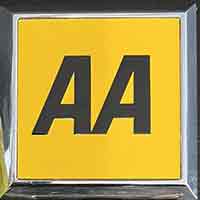
The AA Automobile Association owes its origins to a small band of men who got together to warn fellow motorists about speed traps. By the mid-20th century, the membership was over a million. This page describes and illustrates the roadside help that the AA gave to members around this time, how AA mechanics patrolled the roads by motorbike, how drivers needing help could contact them without the benefit of today’s mobile phones and how an AA patrolman - known just as an AA man - could be recognised.
____
By the webmaster based on her early recollections, discussions with older people and research in museums
When I was growing up in the 1940s and 1950s, most car owners seemed to belong to the AA (the Automobile Association) to help them in the event of breakdown, etc. Their cars sported a badge to prove it which came free with membership. These were usually attached somewhere on the front of the car, often on the radiator.
Whenever an AA patrolman saw a car with an AA badge on it, he would salute the driver.
When the AA man did not salute - a warning!
contributed by Mike Wheale, a car enthusiast
There was an exception to AA patrolmen saluting members of the AA, recognised by the badge on their cars. If there was a police speed trap ahead, the AA man would not salute, and this was a warning. Because he did nothing, he couldn't later be accused and charged with signalling the traps to motorists. (Before radar speed traps, the traps consisted of policemen with stop watches in separate police cars communicating by radio.)
How to get help from the AA when in trouble on the road
This was a time when neither drivers nor anyone else had mobile phones, but when in trouble on the road, there were other ways of getting help than from from the AA:
1. Wait for an AA man to drive by
AA patrolmen, who were also mechanics, would drive around on motorbikes which were readily recognisable. They had yellow sidecars which held various tools and maps. There seemed to be plenty of them, as we always seemed to see one on every road journey. We never needed one, but if we had, we probably wouldn't have had to wait long, provided that we were not in the depths of the country.
These patrolmen were widely known as AA men. They wore brown overalls and helmets.
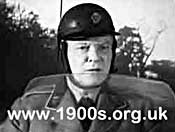
A 1940s or 1950s AA man - detail from an
old film
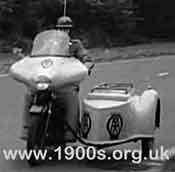
The AA man arriving by motor bike and sidecar to help an AA member in difficulty
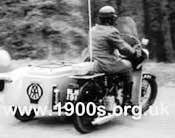
The AA man driving away to further patrol the roads to offer more help to AA motorists

An AA badge for attaching to the front of a car to show membership of the AA. Note the membership number embossed at its base.
2. Find and use an AA phone box or public payphone
At strategic points along main roads and at junctions there were AA telephone boxes at the roadside. (There were of course no motorways.) Members were provided with a key to get into the box and phone for help. There were also public phones but they were few and far between along rural roads, there was no guaranteed that getting to one did not necessitate a long walk.
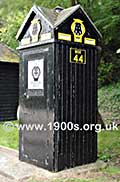
An AA phone box, photographed in Amberley Heritage Museum
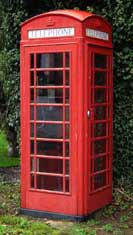
A 1940s50s public phone box
3. Flag down a passing car
Traffic was sparse in those days and car drivers seemed to regard other car drivers almost as members of the same social circle who they could call on rather like friends. It was not unusual to be flagged down at a roadside and be asked to be dropped off at the next garage or phone box.
The competition, the RAC
The RAC (the Royal Automobile Club) was a similar organisation. Yet it must have been smaller because I don't remember seeing any RAC men on the roads.
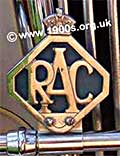
An RAC badge for attaching to the front of a car to show membership
My mother always gave the impression that the RAC was for more affluent motorists than us - but that was the sort of thing she always said and not necessarily the case.
| sources | webmaster | contact |
Text and images are copyright
If you can add anything to this page or provide a photo, please contact me.



